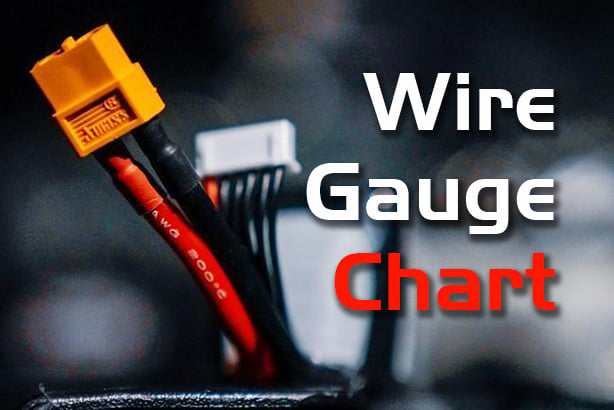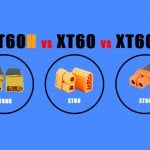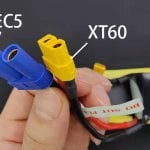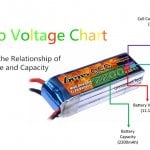Non-compliant wires not only affect the efficiency of power transmission but may also pose a safety hazard. So it is very important to use the proper wire gauge. What are the commonly used wire gauges in RC? Such as XT30, XT60, and so on. If you are confused by this, then the following will be useful to you.
| Connector Type | Ampacity | Wire Gauge |
| XT30 | 30A | 16-18AWG |
| XT60 | 60A | 12-14AWG |
| XT90 | 90A | 10-12AWG |
| EC3 | 60A | 12-14AWG |
| EC5 | 120A | 10-12AWG |
| Deans or T | 60A | 12-14AWG |
These are commonly used plugs and wire gauges. In addition, the detailed wire gauge Chart is at the bottom.
(Tips: The wire diameter is graded in AWG, the smaller the number, the larger the wire diameter.)
Which wire gauge to choose for XT30 and XT60?
It depends on how you fly or drive.
My top picks: XT30 with 16AWG, and XT60 with 12 AWG.
Reason: Backward compatibility. If we’re talking about an FPV quad, whether it’s freestyle or racing, there’s nothing wrong with it.
Specifications of XT30 and XT60:
| Features | XT30 | XT60 |
| Wire gauge | 16-18 AWG | 12-14 AWG |
| Amperage | 30A Continuous / 60A burst | 60A Continuous / 180A burst |
| Bullet diameter size | 2.5mm | 4.3mm |
| Weight | 1.7g | 6g |
| Rated voltage | DC 500V | DC 500V |
| Resistance | 0.7mΩ | 0.4mΩ |
| Times of use | 1000 | 1000 |
| Temperature | 20℃ to 120℃ | 20℃ to 120℃ |
Wire Gauge Chart
| AWG | Ampacity | Resistance | Diameter |
| 4 | 0A | 0.0008mΩ | 9mm |
| 6 | 350A | 0.0013mΩ | 8.5mm |
| 8 | 180A | 0.0025mΩ | 6mm |
| 10 | 150A | 0.0036mΩ | 5.5mm |
| 12 | 100A | 0.0055mΩ | 4.5mm |
| 14 | 70A | 0.0093mΩ | 3.5mm |
| 16 | 30A | 0.0145mΩ | 3mm |
| 18 | 20A | 0.0242mΩ | 2.3mm |
| 20 | 10A | 0.037mΩ | 1.8mm |
| 22 | 8A | 0.063mΩ | 1.7mm |
| 24 | 5A | 0.093mΩ | 1.5mm |
| 26 | 3A | 0.123mΩ | 1.5mm |
Due to different materials and quality, there may be slight errors in the above values.
Frequently Asked Questions
Exceeds current rating
What you need to know is that the wires have resistance and will lose some of the power and generate heat. In the case of the same material, the thinner the wire, the greater the resistance.
Exceeding the rating of the wire can lead to several serious consequences, such as burnt ESC and silicone insulated wires, melted solder, and more. If we’re talking about RC planes, you’re likely to crash in flight because of this. Likewise, if the wires are too thin, the battery can’t provide enough power to the motor.
This is why it is important to use the proper connectors and wire gauges. (Tips: Obtaining the proper wire gauge and connectors can extend the life of the device.)
However, most people choose adapters instead of soldering for convenience, which is a safety hazard.
What are single-strand and multi-strand?
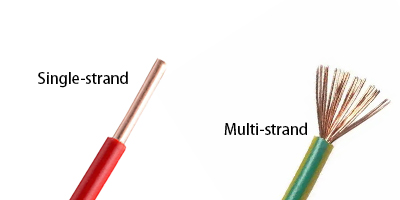
A single-strand wire is a relatively thick wire, also known as a hard wire; a multi-strand wire is a wire composed of many thin copper wires, also known as a soft wire, which is relatively soft.
The heat dissipation performance of the multi-strand wire is better than that of the single-strand wire because the multi-strand wire has a certain gap.
Multiple strands are your best option in RC builds.
Insulation material: PVC vs silicone
Electrical properties: Silicone wire has high voltage resistance and can reach tens of thousands of volts. PVC wire is generally only a few hundred volts. The current performance is the same for both and is generally determined by the internal conductor.
Physical properties: In terms of softness, the silicone wire is relatively soft. And PVC is relatively hard. At low temperatures, PVC wire is softer than silicone wire.
Temperature resistance: Silicone wire can exceed 200℃, while PVC wire can only withstand 70-100℃.
